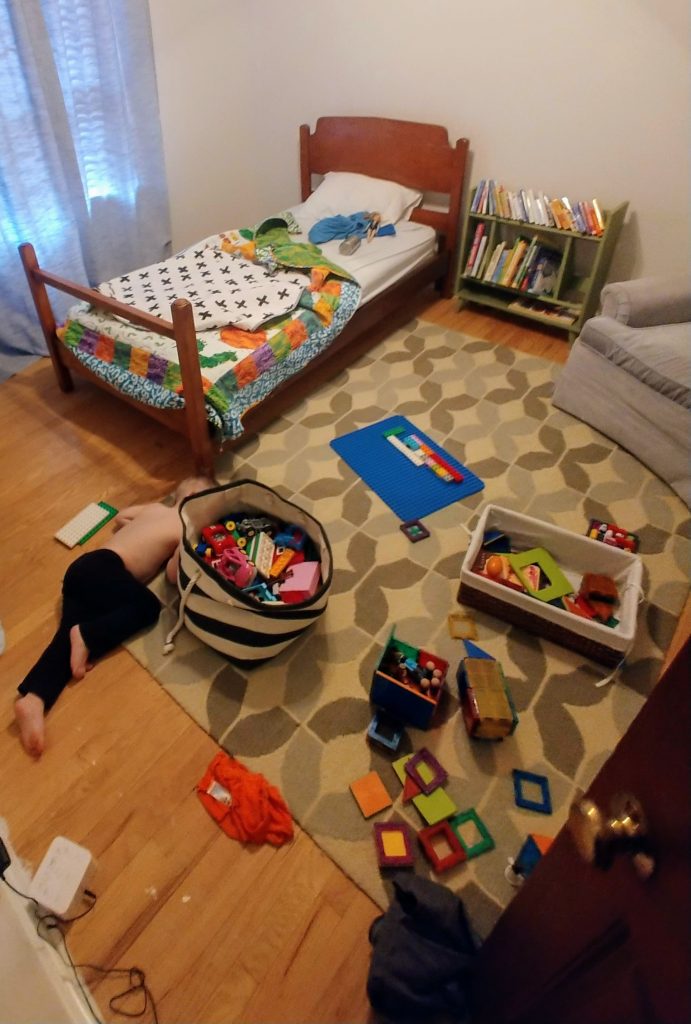Some of the links on this page are affiliate links. When you make a purchase through an affiliate link, I earn a commission at no cost to you. See my entire disclosure policy for all the boring details.
If naptime has gone CRAZY at your house, you’re in the right spot! In this post, you will learn:
- When do babies drop to one nap and how do you know if your baby is ready?
- What nap transitions look like and some nap transition tips
- The 2 to 1 nap transition & dropping the second nap
- Toddler naps (and toddler nap issues)
We had 4 babies in 5 years and they’ve all more or less followed the same general pattern. When they were newborns, they slept all the time. Eventually, they went from 4 naps to 3 naps to 2 naps to 1 nap to just an afternoon quiet time. Basically, a small person in our house has been in some sort of daytime sleep transition since 2013. Here’s how we’ve managed the nap transitions for each age.
2 Important Things to Know Before You Read This Post
- Every age and time in this post is an approximation. I choose to use age/ time because it makes it easier to write and read this post. When you read “3 months” think “3 months -ish” or “sometime around 3 months.” When you read 7:00am, think “whatever consistent time I want my baby to wake each day.”
- Also, as is the case with all my “how to” posts, no system is perfect. Everything is a principle. Trust your instincts with your own children. From my sleep tips – take what works for you and ditch the rest. Join the conversation in the comments to encourage one another in this space.
How to Know When to Transition to One Nap:
Another Sleep Time Gets Messed Up
Many children between 4 months and 15 months (ish) will fall into a routine of a morning nap and an afternoon nap.
At some point in there (around 10-15 months ish), they’ll go down for the morning nap, but have trouble sleeping in the afternoon.
Ding ding ding! This is one of the top signs they’re ready to transition to one less nap.
As your child gets older… your toddler/ preschooler will drop his/her only nap of the day. (And all the parents said: NOOOO!!!)
You’ll notice because he might have trouble falling asleep at naps. This could lead to marker on your walls… if you were, ya know, smart enough to leave a marker in the room with your toddler who is dropping the nap. #speakingfromexperience
OR… if the aforementioned toddler DOES fall asleep, he will want it to be awake time until 9, 10, 11 pm, thus interfering with night sleep. Again, if a later sleep time is getting messed up, you know it’s time for your little one to drop naps.
My #1 tip is to bridge the gap with a “parent-led snooze.”
This is the solution that’s worked best for us. Of course it’s not the only one 🙂
If you rely a lot on schedules and nap routines, embrace that the nap transition is going to be a bit wonky for a while. It’s very temporary, so try not to get your panties in a bunch (like I did with our first).
Here is how we lead our kids through the nap transition: put your child down for the nap he needs to drop, but wake him after 30 minutes.
Some kids will wake cranky from this snooze. Observe your child and decide the best way you can help them – do they need a slow wake, a snuggle from mom, a favorite toy or book or quiet post nap activity or walk?
Eventually, even the 30 minute snooze will probably interfere with the child’s sleep later. So, try a 15 minute snooze. Who doesn’t feel better after a 15 minute cat nap!? (And all the parents said: MEEEE!!!)
At some point, most kids will just be able to survive until the later nap time without a snooze. Then, congratulate yourself! You’ve survived a nap transition. If you have a particularly sleepy child, you might have to bump up that later nap. There’s an example below.

2 to 1 nap transition example
If your baby is doing the 2 to 1 nap transition, your 6-12 month old nap schedule might have been:
- Nap 9-10:30
- Nap 1:30-3:30
- Bedtime 7:30 pm.
After the transition, a one nap schedule might be:
- 1 Nap from 12-3 (this got moved up a little)
- Bedtime at 6:30-7 (this got moved up a little too…)
The nap time and night time might be able to shift a little later as the baby gets older, depending on your daily lifestyle and preferred bedtime for your child 🙂
We have had a standing nap time from approximately 1-3pm since my oldest was 18 months. She’s 6 1/2 as of this writing… once she grew out of her naps completely, we shifted to more of an afternoon quiet reading and playtime.
Flex the one nap schedule to work for your family
I know some people whose husbands get off work late, so they prefer for their kids to go to bed at 9pm so that they get time with daddy. They’ll do a nap later (around 2-4 pm) so the kids can stay up later without getting cranky.
My husband and I are early-to-bed-early-to-rise so we aim for a 7:30 bedtime and 7:00 am wake up time for the kiddos.
Signs Baby is Ready for One Nap
Many of these have been mentioned throughout the article but I thought it’d be helpful to summarize with this list of signs baby is ready to drop that morning nap:
- The baby can’t fall asleep for his afternoon nap
- Not acting tired – staying very active & happy to be awake
- Doesn’t get tired until 10:30 or 11:30 am
- Starts crying for extended amount of time in crib, when ordinarily the baby would be fine to take a nap
The nap transition is hard, but the payoff is increased flexibility!
Every time the baby drops one nap, I feel like celebrating!! It’s much easier to make plans, and it frees up the schedule after babies drop to one nap!
Plus, all of our children have become MUCH more flexible in terms of nap times, quiet times, and bedtimes between the ages of 2 ½ – 3.
Before age 2 ½ (ish), if our child got down for a nap/ bedtime really really late, he or she kind of turned into a toddler-monster. (Anyone know what I mean!?)
They just got so so tired. At some point, they seem to grow into being able to stay up and flex a little more… without becoming a total terror 🙂

Observe, Help Them Transition, and Snuggle when all else fails!
Remember, it’s all about observing what your child needs for this nap transition, and deciding what’s best for your child on any one day. When you don’t know what’s best (me, all the time), snuggling and reading seem to be the best cures over here.
At the end of the day, if your child is acting like a monster, fill his tummy, give him a hug and kiss, and put him to bed. Start over tomorrow. New mercies every morning, friends. Don’t wish it all away. The next season will be here in the blink of an eye.
Do you have any tips or cues for helping baby drop a nap or surviving the nap transitions? Feel free to chime in below in the comment section.
Also, if this was helpful, would you share on facebook and/ or pinterest! 🙂



